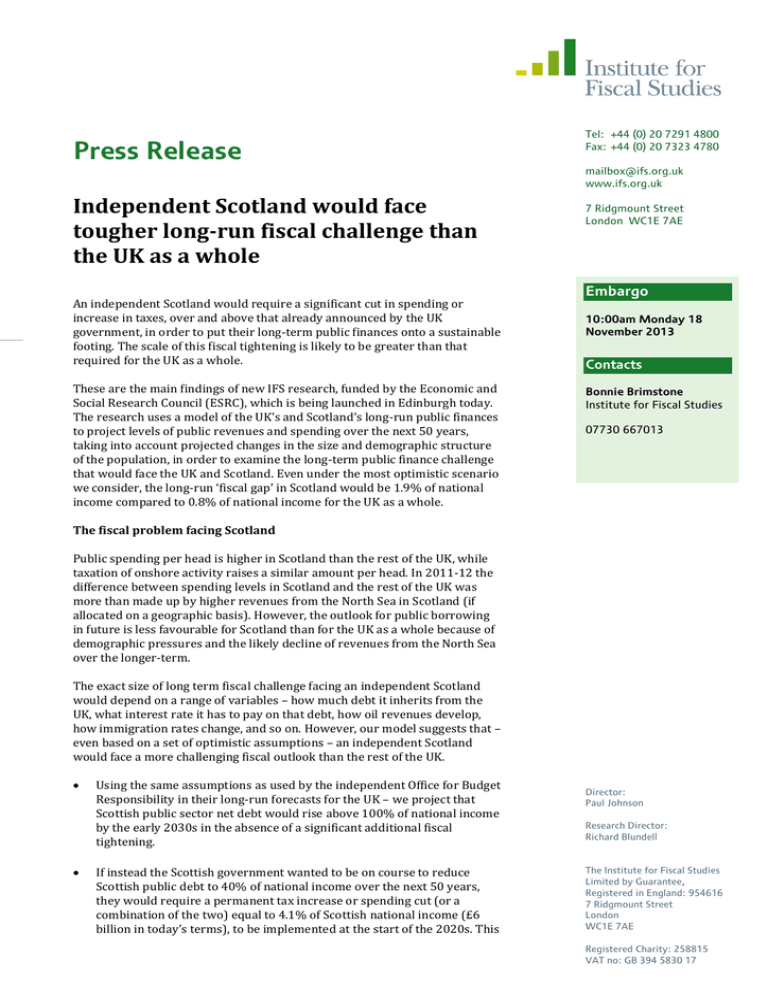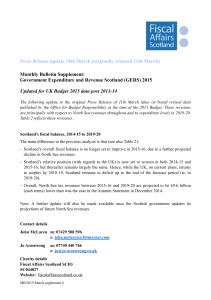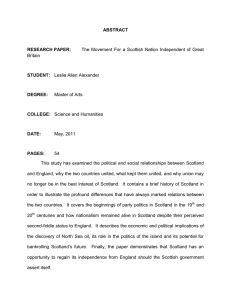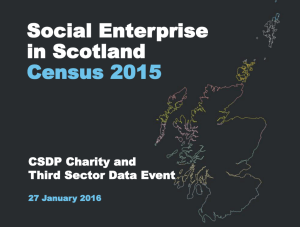Press Release Independent Scotland would face
advertisement

Press Release Tel: +44 (0) 20 7291 4800 Fax: +44 (0) 20 7323 4780 mailbox@ifs.org.uk www.ifs.org.uk Independent Scotland would face tougher long-run fiscal challenge than the UK as a whole An independent Scotland would require a significant cut in spending or increase in taxes, over and above that already announced by the UK government, in order to put their long-term public finances onto a sustainable footing. The scale of this fiscal tightening is likely to be greater than that required for the UK as a whole. These are the main findings of new IFS research, funded by the Economic and Social Research Council (ESRC), which is being launched in Edinburgh today. The research uses a model of the UK’s and Scotland’s long-run public finances to project levels of public revenues and spending over the next 50 years, taking into account projected changes in the size and demographic structure of the population, in order to examine the long-term public finance challenge that would face the UK and Scotland. Even under the most optimistic scenario we consider, the long-run ‘fiscal gap’ in Scotland would be 1.9% of national income compared to 0.8% of national income for the UK as a whole. 7 Ridgmount Street London WC1E 7AE Embargo 10:00am Monday 18 November 2013 Contacts Bonnie Brimstone Institute for Fiscal Studies 07730 667013 The fiscal problem facing Scotland Public spending per head is higher in Scotland than the rest of the UK, while taxation of onshore activity raises a similar amount per head. In 2011-12 the difference between spending levels in Scotland and the rest of the UK was more than made up by higher revenues from the North Sea in Scotland (if allocated on a geographic basis). However, the outlook for public borrowing in future is less favourable for Scotland than for the UK as a whole because of demographic pressures and the likely decline of revenues from the North Sea over the longer-term. The exact size of long term fiscal challenge facing an independent Scotland would depend on a range of variables – how much debt it inherits from the UK, what interest rate it has to pay on that debt, how oil revenues develop, how immigration rates change, and so on. However, our model suggests that – even based on a set of optimistic assumptions – an independent Scotland would face a more challenging fiscal outlook than the rest of the UK. Using the same assumptions as used by the independent Office for Budget Responsibility in their long-run forecasts for the UK – we project that Scottish public sector net debt would rise above 100% of national income by the early 2030s in the absence of a significant additional fiscal tightening. If instead the Scottish government wanted to be on course to reduce Scottish public debt to 40% of national income over the next 50 years, they would require a permanent tax increase or spending cut (or a combination of the two) equal to 4.1% of Scottish national income (£6 billion in today’s terms), to be implemented at the start of the 2020s. This Director: Paul Johnson Research Director: Richard Blundell The Institute for Fiscal Studies Limited by Guarantee, Registered in England: 954616 7 Ridgmount Street London WC1E 7AE Registered Charity: 258815 VAT no: GB 394 5830 17 would be in addition to implementing those cuts already pencilled as part of the UK government’s fiscal tightening, which is not currently planned to be completed until April 2018 – 2 years after Scotland would become independent. The outlook for borrowing and debt are very sensitive to the assumptions made in the model. The fiscal problem facing Scotland would be greater if North Sea revenues decline by more than we assume in our basic model, or if the interest rate were higher. There is a real risk that an independent Scotland would face higher interest rates on its debt than the UK as a whole. On the other hand, the fiscal problem would be smaller if net inward migration was higher, or North Sea revenues more buoyant, or if Scotland took a smaller proportion of UK debt. These are certainly feasible scenarios. However, even under the most optimistic scenario we have considered – in which Scotland experiences ‘high migration’, the same productivity growth and interest rates as assumed by the OBR for the UK, takes a share of debt equal to 40% of Scottish national income, and enjoys high North Sea revenues in the medium term, we still estimate that the ‘fiscal gap’ for Scotland would be 1.9% of national income (or £3 billion). This is significantly greater than the ‘fiscal gap’ estimated for the UK: we estimate that the UK would need a permanent fiscal tightening of 0.8% of national income, implemented in 2021–22, to put debt on a course to reach 40% of national income by 2062–63. A 1.9% of national income fiscal tightening would entail difficult choices for the Scottish government. It would require policy action equivalent to around a 9 percentage point increase in the basic rate of income tax, an 8 percentage point increase in the standard rate of VAT, a 6% reduction in total public spending, or a 8% reduction in public service spending. This would need to come on top of the fiscal tightening already planned by the UK government through to 2017–18. Gemma Tetlow, a Programme Director at the IFS and an author of the report, said: “An independent Scotland would face even tougher choices than those faced by the UK over the longer term. In 2011–12, higher public spending per person in Scotland was more than matched by higher revenues from activity in the North Sea. However, over the long-term, revenues from the North Sea will probably decline and official population projections suggest that the average age of the Scottish population will increase more rapidly than for the UK as a whole, putting greater upward pressure on many areas of public spending. As a result, to ensure long-run fiscal sustainability, an independent Scotland would need to cut public spending and/or increase other tax revenues more than would be required across the UK as a whole.” Public spending and taxation in Scotland Also being presented at the Edinburgh event are recently published pieces of research looking at public spending and taxation. Among other things, this work finds that: Benefit spending as a whole was only 2% higher in Scotland than in Great Britain as a whole in 2011–12. The areas where benefit spending differed substantially between Scotland and the rest of Great Britain were disability benefits and housing benefit. Higher disability benefit spending The Institute for Fiscal Studies Limited by Guarantee, Registered in England: 954616 7 Ridgmount Street London WC1E 7AE per person is associated with poorer self-reported health and disability statuses. And lower spending per person on housing benefit reflects lower-than-average rents in the private and social housing sectors, and a higher proportion of claimants renting from a social landlord. Spending on public services in Scotland is 17% higher per person than for the UK as a whole. But again this average masks significant variation by service-area with spending on health and education, the two biggest areas of public services spending, closer to the UK average, and much bigger differences for smaller service areas such as housing, transport, recreation and culture and economic development. The differences in spending patterns have been growing over time, suggesting that the Scottish government has been using the powers it has under existing devolution arrangements to prioritise services differently to the UK government’s decisions for England. Independence would give Scotland an opportunity to design a much more efficient tax system than the UK currently has. While pressures on the public finances would point towards tax increases, the characteristics of an independent Scotland suggest a number of ways in which the ‘optimal’ tax system for Scotland might involve lower taxes than that for the UK. The Scottish income distribution is more equal than the UK’s, so the scope and need to redistribute through high rates of income tax would be less. There is less congestion on Scottish roads, so optimal motoring taxation would be lower. And independence could lead to tax competition and cross-border shopping, creating pressures to reduce taxes such as corporation tax and excise duties. ENDS Notes to Editors: 1. For embargoed copies of the report or other queries, contact: Bonnie Brimstone at IFS: 07730 667013, bonnie_b@ifs.org.uk. 2. This is the fifth major publication from an IFS research programme which aims to clarify some of the fiscal choices that might face Scotland were it to become independent. Outputs associated with this project are being produced under the auspices of the Centre for Microeconomic Analysis of Public Policy, an ESRC research centre hosted by the IFS. More information on the IFS website: http://www.ifs.org.uk/projects/408. 3. ESRC programme of work “The future of the UK and Scotland”: The ESRC is supporting a programme of work addressing issues around the future of Scotland. The work will provide robust independent research based evidence. It will aim to both inform the debate in the run-up to the referendum and assist in planning across a wide range of areas which will be affected by the outcome of the vote, whether for independence or the Union. These include voting, culture and identity, business intelligence, fiscal and monetary policy, policy development, building of new constitutional arrangements, and defence and administrative practice - particularly in public service delivery. http://www.futureukandscotland.ac.uk/. 4. A conference to launch this and other work from the programme is taking place th on 18 November in Edinburgh. More details at: http://www.futureukandscotland.ac.uk/events/fiscal-implications-independentscotland. Please let Bonnie Brimstone know if you wish to attend. The Institute for Fiscal Studies Limited by Guarantee, Registered in England: 954616 7 Ridgmount Street London WC1E 7AE 5. The Office for Budget Responsibility publishes a long-run forecast for the UK’s public finances on an annual basis in their Fiscal Sustainability Report. The latest forecast was published in July 2013 and is available at: http://budgetresponsibility.org.uk/fiscal-sustainability-report-july-2013/. This research has been produced by researchers under the auspices of the ESRC Centre for the Microeconomic Analysis of Public Policy at IFS. The Institute for Fiscal Studies Limited by Guarantee, Registered in England: 954616 7 Ridgmount Street London WC1E 7AE




